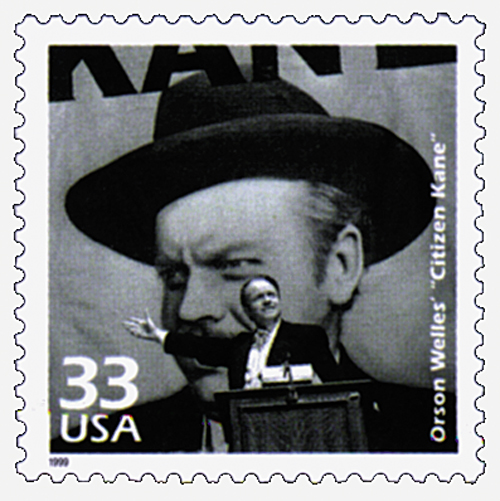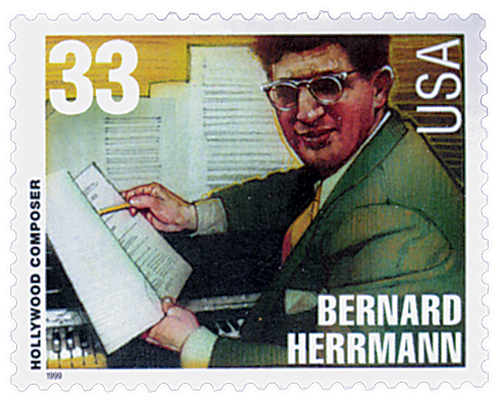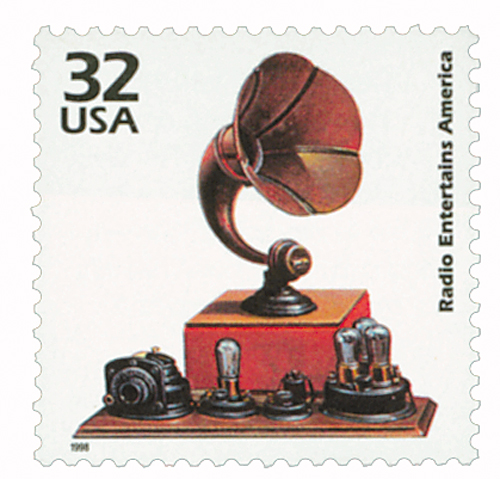
# 3184i FDC - 1998 32c Celebrate the Century - 1920s: Radio-America
32¢ Radio Entertains America
Celebrate the Century – 1920s
City: Washington, DC
Quantity: 12,533,000
Printed By: Ashton-Potter (USA) Ltd
Printing Method: Lithographed
Perforations: 11.5
Color: Multicolored
War Of The Worlds Broadcast

On October 30, 1938, Orson Welles created a panic with his War of the Worlds broadcast, which some listeners believed was a real news story.
The now legendary broadcast was based on British author H.G. Wells’ 1898 novel of the same name. The broadcast was part of the program Mercury Theatre on the Air, an hour-long radio drama show that presented literary works.
Reportedly, Orson Welles was inspired by a 1926 radio hoax, Broadcasting the Barricades, in which a radio announcer described a riot in London. According to Welles, “I had conceived the idea of doing a radio broadcast in such a manner that a crisis would actually seem to be happening, and would be broadcast in such a dramatized form as to appear to be a real event taking place at that time, rather than a mere radio play.”

Screenwriter Howard E. Koch adapted the story for the dramatic radio broadcast and Bernard Herrmann and his orchestra provided the music. The broadcast began at 8 pm on Sunday night, October 30, 1938. The program began with a paraphrase of the beginning of the novel, updated to reflect the times. This was followed by a weather report and then music from a dance band. Then the music was interrupted by a news flash about strange explosions on Mars.
The program continued on, switching between the staged musical performances, and increasingly frightening news reports of a crashed alien ship in Grover’s Mill, New Jersey. As the story continues, an alien attacks a group of onlookers, fights with the military, and it’s eventually announced that more Martian cylinders have fallen all over the country. When the program ended, Welles returned to the broadcast as host of his show and told listeners that the story had been a Halloween joke.

During the course of the broadcast, it was repeatedly stated in between performances that the program was a play. However, some listeners appeared to have missed the introduction and perhaps these interludes, as panic soon set in for some people. During the recording, several police officers entered the station to stop the show, but they were held back. Soon the station’s telephone switchboard was lit with calls from terrified listeners. And reporters flooded the station asking for updates on the horrible events.

A Times Square marquee was lit with the words “Orson Welles Causes Panic.” Welles feared his career was over. The next day he had to give interviews explaining the play and defending his choice to present it as he had. Coverage of the story ran in newspapers for weeks, with at least 12,500 articles being printed over the next three weeks.
It’s often been reported that the broadcast led to widespread panic. While it’s true some listeners did believe the news story Welles presented, there wasn’t the mass hysteria reported on by many newspapers. In fact, some listeners only heard part of the story, and thought the threat was Germany, not aliens. It’s been suggested that the newspapers of the day over-exaggerated their accounts of the public’s reaction, in part to discredit the radio, which some saw as their competition.
Click here to listen to the full War of the Worlds broadcast.
32¢ Radio Entertains America
Celebrate the Century – 1920s
City: Washington, DC
Quantity: 12,533,000
Printed By: Ashton-Potter (USA) Ltd
Printing Method: Lithographed
Perforations: 11.5
Color: Multicolored
War Of The Worlds Broadcast

On October 30, 1938, Orson Welles created a panic with his War of the Worlds broadcast, which some listeners believed was a real news story.
The now legendary broadcast was based on British author H.G. Wells’ 1898 novel of the same name. The broadcast was part of the program Mercury Theatre on the Air, an hour-long radio drama show that presented literary works.
Reportedly, Orson Welles was inspired by a 1926 radio hoax, Broadcasting the Barricades, in which a radio announcer described a riot in London. According to Welles, “I had conceived the idea of doing a radio broadcast in such a manner that a crisis would actually seem to be happening, and would be broadcast in such a dramatized form as to appear to be a real event taking place at that time, rather than a mere radio play.”

Screenwriter Howard E. Koch adapted the story for the dramatic radio broadcast and Bernard Herrmann and his orchestra provided the music. The broadcast began at 8 pm on Sunday night, October 30, 1938. The program began with a paraphrase of the beginning of the novel, updated to reflect the times. This was followed by a weather report and then music from a dance band. Then the music was interrupted by a news flash about strange explosions on Mars.
The program continued on, switching between the staged musical performances, and increasingly frightening news reports of a crashed alien ship in Grover’s Mill, New Jersey. As the story continues, an alien attacks a group of onlookers, fights with the military, and it’s eventually announced that more Martian cylinders have fallen all over the country. When the program ended, Welles returned to the broadcast as host of his show and told listeners that the story had been a Halloween joke.

During the course of the broadcast, it was repeatedly stated in between performances that the program was a play. However, some listeners appeared to have missed the introduction and perhaps these interludes, as panic soon set in for some people. During the recording, several police officers entered the station to stop the show, but they were held back. Soon the station’s telephone switchboard was lit with calls from terrified listeners. And reporters flooded the station asking for updates on the horrible events.

A Times Square marquee was lit with the words “Orson Welles Causes Panic.” Welles feared his career was over. The next day he had to give interviews explaining the play and defending his choice to present it as he had. Coverage of the story ran in newspapers for weeks, with at least 12,500 articles being printed over the next three weeks.
It’s often been reported that the broadcast led to widespread panic. While it’s true some listeners did believe the news story Welles presented, there wasn’t the mass hysteria reported on by many newspapers. In fact, some listeners only heard part of the story, and thought the threat was Germany, not aliens. It’s been suggested that the newspapers of the day over-exaggerated their accounts of the public’s reaction, in part to discredit the radio, which some saw as their competition.
Click here to listen to the full War of the Worlds broadcast.












